History
Campagnolo Super Record was released in 1974 as the successor to Campagnolo’s top tier group set, Nuovo Record. The Super Record group set was in production from 1974 to late 1980’s. The Super Record brakes were a single pivot (side-pull) design and manufactured from durable lightweight alloy with a satin anodised finish. Campagnolo also released 2 special editions of the Super Record group set which featured slight variations in the markings on the brake callipers.
Campagnolo introduced it’s first side-pull brakes (as Record) in 1968. In those days, many bikes were equipped with centre-pull brakes, however it wasn’t long before they were highly sought after.
Campagnolo’s side-pull brakes were constructed from superior materials which provided strength and stiffness to match the mechanical advantage of centre-pull brakes, but were expensive. Over the years they were widely copied by many manufacturers.
In 1986 Campagnolo also released a Cobalto version of this classic brake calliper whilst they were sorting out problems with the new C-Record Delta brakes as explained later on.
Note: Be sure not to confuse Campagnolo Victory brakes with Super Record brakes as they are visually very similar and discussed later in this article.
Super Record Brakes (First Version)

The early version of Super Record brakes are easily distinguishable by the flat quick release lever (no dome). The brake shoe wheel guides were plain metal, not covered in black rubber like the later versions.
Super Record Brakes (Second Version)

These brakes were released around 1978 and featured a few small variations to the early Super Record brakes. Firstly, the brake shoe wheel guides were now covered in black rubber. Secondly and more importantly, the quick release lever was changed from a flat shape to a dome shape to comply with the U.S. Government CPSC rules.
Super Record Brakes (Third Version)

The third release of these brakes included a few changes that make it quite easy to differentiate from the previous versions. The most obvious difference is the cursive Campagnolo lettering on one arm. Also both the quick release nut and mounting bolt are cone shaped instead of bell shaped.
Campagnolo 50th Anniversary Brakes
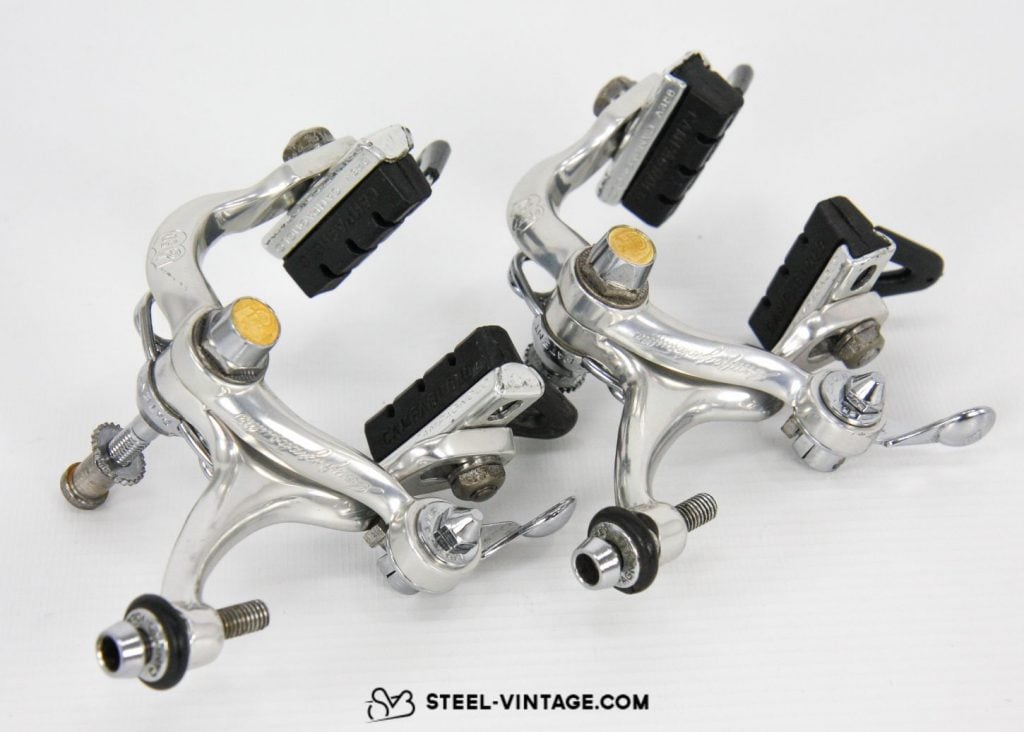
Image courtesy of steel-vintage.com
These brakes were included in the Campagnolo 50th Anniversary group set which was essentially Super Record components that featured special gold badging and 50th anniversary markings. Otherwise they are essentially the same as the 3rd version Super Record brakes.
Colnago 30th Anniversary Brakes
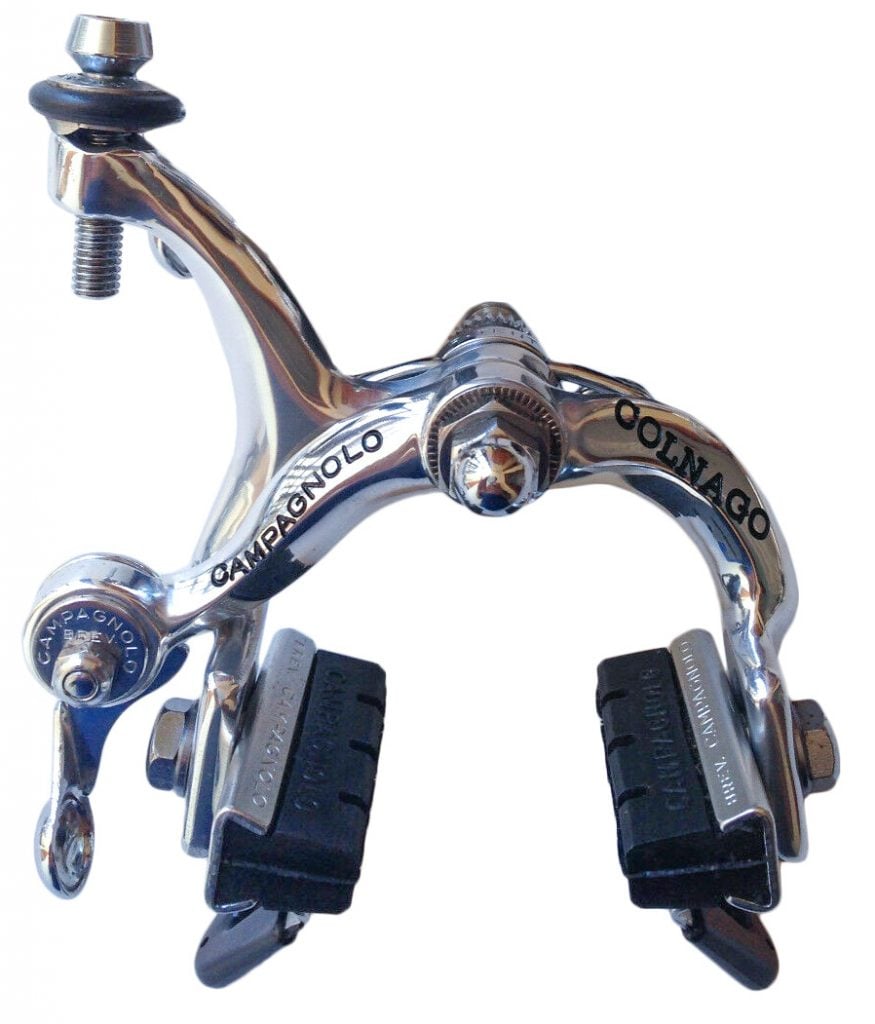
In 1984 Campagnolo manufactured a special version of the Super Record group set for Colnago to celebrate the 30th Anniversary of Colnago (founded in 1954). These group sets are very rare and were originally fitted to a limited release of Colnago Arabesque bicycles.
Campagnolo C-Record Cobalto Brakes
Probably the centre piece of the C-Record group set (which replaced Super Record in 1986) was the new Delta brakes. Unfortunately however, the Delta brakes looked much better than they performed and whilst Campagnolo was fixing some technical issues with the Delta brakes, the Cobalto brakes were supplied instead and have become a collector’s item.
The Cobalto brakes were nearly identical to the 3rd version of the Super Record brakes with the exception of the centre bolt which was essentially the bolt used in the 50th anniversary edition, but the gold badging was switched to a Cobalto blue stone. The Campagnolo script on the calliper arm was also painted blue.

Image courtesy of steel-vintage.com
These brakes were not officially part of the Super Record group set however as per the image below, you can see that this set was supplied in a Super Record box. ‘Freni’ is Italian for brakes (according to Google translate).
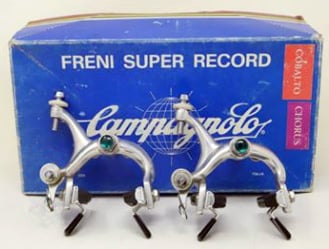
Image courtesy of Art Bikes
Quick-Release Mechanism

Campagnolo brakes featured a quick release mechanism that made it quick to open the brakes for wheel removal or changes. It was designed around an eccentric cam which like many modern day brake callipers allowed you to open the arms to varying degrees.
External or Recessed Mounting Nuts

Right Image: Recessed Brake Mounting Nut
Early versions of the Super Record brakes were supplied with an external mounting nut, whilst later versions were equipped with a nut designed for recessed mounting into the frame. The recessed mounting system is still used for modern bikes. Your bicycle frame will dictate which mounting version you require. My early-mid 1980’s Colnago frames were designed for use with recessed brake nuts.
Why use Star Washers?
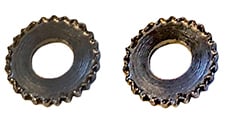
Campagnolo solved the problem of keeping side-pull brakes centered by adding star washers to the frame mounting bolts; 2 washers on the front brake and one washer on the rear brake calliper.
Short or Long Reach Options
Campagnolo catalogs from 1973 to 1985 offered Super Record brakes in 2 different reach sizes: Short Reach (47mm) or Long Reach (52mm). The 5mm difference is in the length of the calliper arms. It is recommended to use the correct length which will be determined by your frame & rim sizes. I use short reach callipers on my early-mid 1980’s Colnago frames with standard 700C road rims.
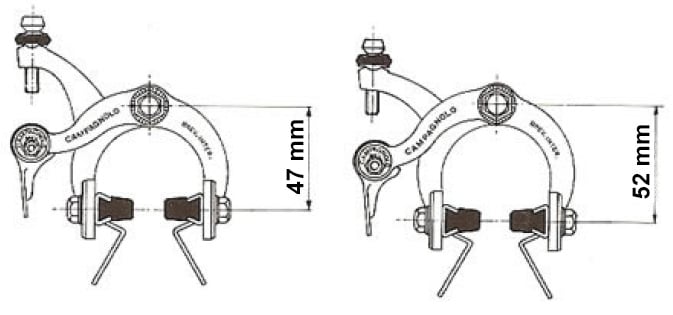
Unfortunately when buying these brakes, most sellers do not know or list the size of the brakes. As there is only 5mm difference, it requires a degree of accuracy when measuring, particularly as the callipers need to be squeezed together (as per the schematic).
Front Brake – Frame Bumper
The short reach (47mm) front brake calliper was fitted with a rubber bumper that is designed to protect the top tube of the frame if the handle bars are rotated fully to the right. Without this bumper, the stirrup arm of the brake hits the frame which can chip the paint or dent the down tube over time.
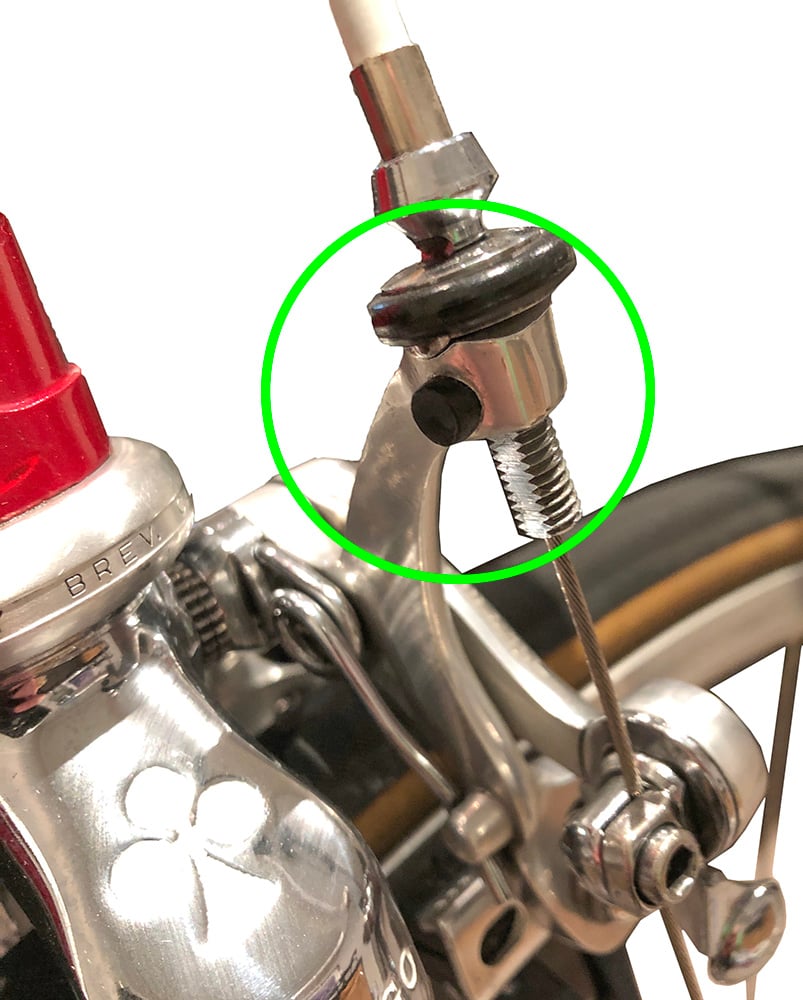
(circled in green)
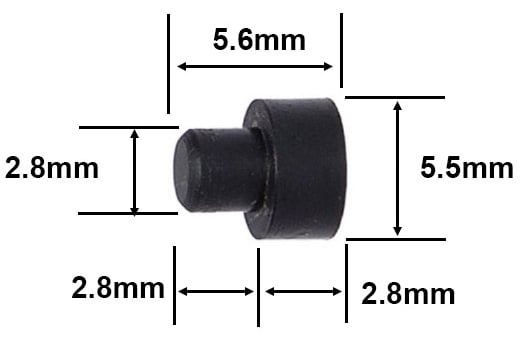
Unfortunately often brakes that are for sale are missing this small part and I have not been able to find a supplier.
Brake Levers Parts Schematic
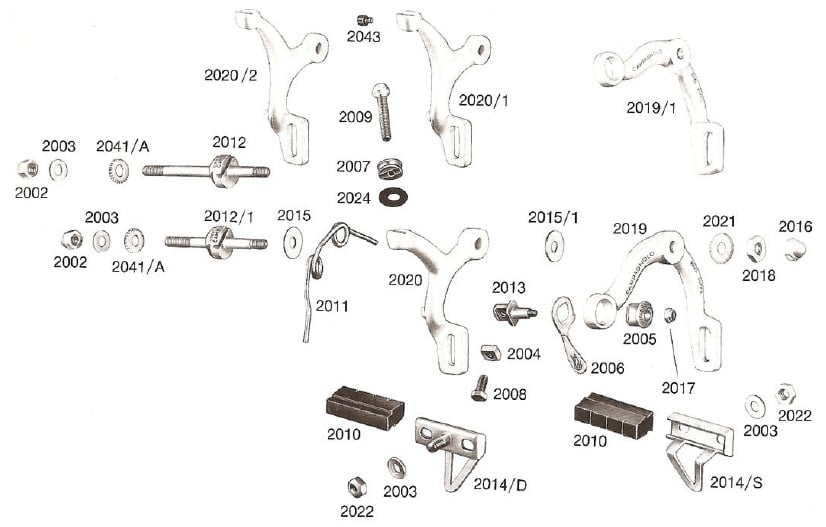
Correct Brake Pad Setup
When fitting brake pads to the callipers, it is EXTREMELY important to have the brake shoes fitted in the correct orientations.

If you examine the Campagnolo brake shoe, you will notice that one end is enclosed with a metal tab (end stop) and the other end is open (exposed rubber). This convenient cartridge design allows you to slide the pad out of the brake shoe for easy replacement. However, this also means you need to be very careful when fitting the brake shoes to the calliper arms. The metal tab must be facing toward the front of the bike, otherwise braking forces can pull the brake pad out of the shoe leaving you with NO brakes. If in doubt, get your local bike shop to check your setup is correct.


Replacing the Brake Pads

At some point your brake pads may run down and need replacing. Luckily this is a simple operation and there are plenty of replacement Campagnolo pads for sale on eBay. Do not throw away the brake shoes as these are valuable vintage parts. Learn how to remove the brake pads.
Adjusting Toe-in on Brake Pads
The original brake shoes do not provide a way to add toe-in to the brake pads which is important if you find your brakes are squealing. There are 2 main options for resolving this issue;
- Replace the vintage brake shoes & pads with a set of modern brake pads that are supplied with a conical washer which allows you to adjust toe-in to eliminate brake squeal. Modern brake pad materials will also improve braking performance and feel. Simple and effective fix, but at the expense of losing the original retro look and feel.
- File the brake pad so that the leading edge of the pad contacts the rim before the rear end. This would most likely need to be repeated with each pad replacement.
- Bend the brake calliper arms to add the required toe-in (which is minimal). Sounds scary but you should only need to do it once. Park Tools used to sell a tool specifically designed for this job, but it became redundant with the advent of conical washers fitted to modern brake shoes. Read my in-depth article on how to fix brake squeal on a vintage bike.
Brake Cables
Campagnolo sold brake cables and outer housings in several different lengths to suit different bike set-ups. The good news is that modern Campagnolo brake cables are compatible with these components. Learn more about Campagnolo brake cables.

Image courtesy of Vintage NOS Bicycle Parts
Campagnolo Victory Brakes
Campagnolo C-Record was released in 1986 to replace Super Record as the premium level group set. In the same year, Campagnolo released the Victory group set which was a second tier group set. The brake callipers and brake levers of this group set are nearly identical to Super Record.
So, if you are shopping for Super Record brake callipers, make sure to pay careful attention to the main difference, which is that Super Record brakes have a different quick release lever.

UK Pricing in 1981
I found a 1981 catalogue for a British cycling shop with pricing as follows;
The Super Record brake set (including brake levers) was GBP 92.00
Super Record Component Weight
I have weighed a set of Super Record components and quite surprisingly, these vintage parts compares quite favourably against the weight of a modern Campagnolo Super Record group set.
Learn more about Campagnolo Super Record
This article is just a small part of my full review of Campagnolo Super Record groupset.
References
I hope you found this article interesting. I have listed the following website pages as general references.
sscycleworks.com
bikeretrogrouch.blogspot.com
steel-vintage.com
Disclaimer!
Please remember that this information is only to be used as a guide.
I consider myself an enthusiast, not an expert. The information I have presented in this article is based on my many hours of online research.
Whilst I enjoy working on my own bikes, I am not a qualified bicycle mechanic. The content of this article is purely illustrative and does not constitute professional advice. For your own safety, any type of work should only be undertaken by a qualified bicycle mechanic. Incorrect assembly of parts could result in equipment damage, personal injury or death.
About Me.
I have been riding and working on my own bikes for many years now. I wanted to share my experiences, knowledge and research with others. My aim is to inspire people to get involved in all aspects of this amazing sport. Cheers.
Comments.
I welcome reader feedback in the comments section. Should you wish to suggest an amendment, please include a note advising the source of your information so that myself and other readers can ascertain the accuracy of your information. Note: Trolling or argumentative comments will be removed as they are counter-productive.
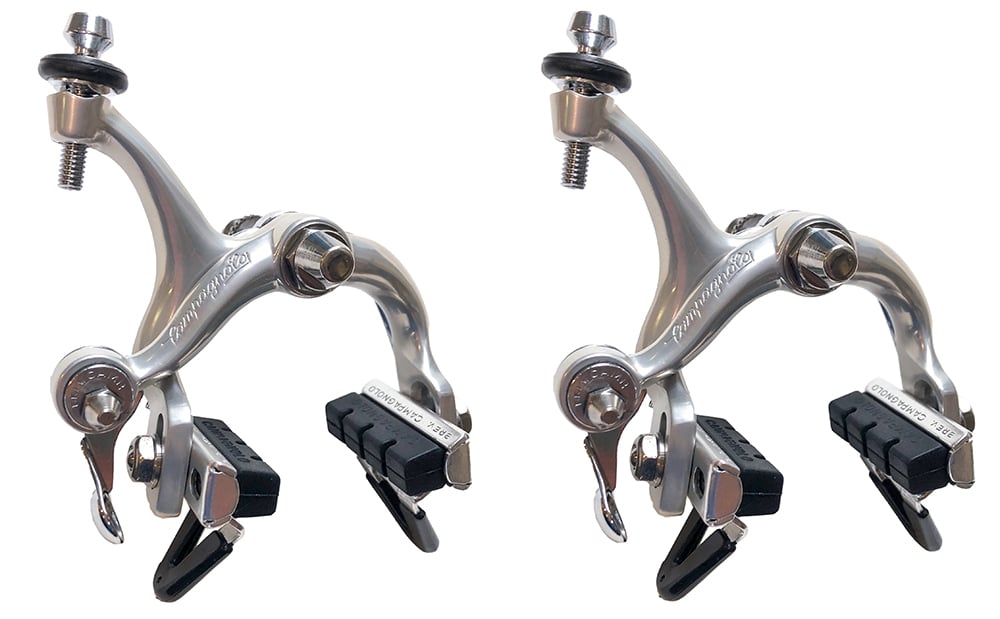
Nice articles. I got one brake with an inscription in the back that says ” st ” any idea about it?
Thanks AbuSundus, sorry I haven’t found any reference to an “st” marking.
I have a set of brakes which are the same as the Victory design exxcept the campagnolo on the same arm as the quick release is in block recessed letters. the other arm has no writing on it. Was this a variation of the Victory model?
I would be interested to know. Many thanks.
Hi Norman, sorry I am not sure, I only researched the SR brakes and noticed Victory were very similar in design so I included them in the article.
True first generation brakes are no-log and do not say CAMPAGNOLO on the brake arms. They start at $600+ a set on EBay. That was a first-year-only (1968) thing.
Thanks Donald for your comments. I’m guessing those brake calipers were officially part of the Record or (Nuovo Record) groupset? This review is focused on the Super Record group which was released to market in the early 70’s.
Greetings… and thank you so much for the truly well documented & informative website. It certainly serves as a very good reference point for the cycling community at large.
I’ve been on a ‘spot-the-difference’ exercise with what I could glean on the internet but could not find anything significant (at least visually) between the Nuovo Record & Super Record brake calipers. While other components could be readily identified (eg. NR & SR rear derailleur), differences seem a little too subtle for the calipers. Are there any design differences between the Nuovo and Super Record calipers?
Hi Teddy, thanks for your comments, they are much appreciated. That is a very good question. I’m no expert on Nuovo Record parts, but I think the pre-1978 Super Record calipers are probably the Nuovo Record calipers. Throughout it’s life, the Super Record group set was sold with other Nuovo Record parts like the wheel hubs, shift levers and bottom bracket (although some upgrade options were available to more exotic titanium versions). The calipers with the cursive Campagnolo script and 50th Anniversary version are the easiest to identify as Super Record specific. But thankfully it makes it easier to build a bike with Super Record when some of the parts are the same as Nuovo Record.
Generally the short reach brakes say “BREV INT.” on the right side caliper arm, whereas the long reach brakes say “BREV INTER.” on the right side caliper arm. Since the long-reach brakes were released first, they started with “BREV INTER.” but had to drop the 2 letter when they offered the short reach brakes later in the life of these brakes.
Nope. I just compared the two and they are identical.
Thanks for the photo of the elusive frame bumper. You gave me a brainstorm idea!
I have Victory brakes that have been bumping my downtube. I’ve been putting big ugly pieces of padded tape on the frame to prevent paint chips, but I just had my frame painted and wanted to use clear frame protectors; unfortunately they don’t offer that much protection.
So I put a dab of clear silicone caulk on the back of the brake arm. When it dries I’ll Dremel it to match the curve of the tube.
Sounds like a great idea, it doesn’t need to be very thick and I doubt anyone will even notice it. It is worth investing some effort to protect the paint and stop a potential dent in the metal.
Isn’t the only difference between Nuovo and Super on the brake levers? (With SR being a little heavier than NR.)
That’s a very good question Reilley. I know there were small differences between Nuovo Record and Super Record brakes in terms of the release lever on the caliper, position and type of engravings and some of the nuts, but in terms of the construction of the caliper arms, material used and spring, unfortunately I’m not sure.
Those Colnago brakes weren’t made by Campagnolo like that. It’s a modification job. They are standard caliper arms that have had the anodising removed in a caustic solution, have had the original (very shallow stamped) logos filed and sanded out, and then had the Colnago logos pantographed on. They were finally mirror polished, with the panto-work infilled with paint, to finish. The same is true of the other Colnago Anniversary parts. They are simply modified standard items. The exception is the outer chainring, which was probably made by Galli or Gipiemme. The chainring of the Colnago Anniversary group is not an original Campagnolo part.
Yes, the standard Campagnolo parts were simply modified, but I presume Campagnolo made the modifications to Colnago’s specification. Not sure how many of these special Campagnolo group sets were produced for Colnago Arabesque, but it would likely be in the hundreds.